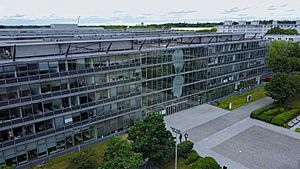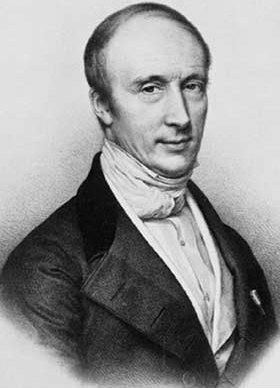École nationale des ponts et chaussées facts for kids
 |
|
|
Other name
|
Ponts |
|---|---|
| Motto | Building the worlds of tomorrow |
| Type | French grande école, member of Institut Polytechnique de Paris |
| Established | 1747 |
| Founder | Daniel-Charles Trudaine |
|
Parent institution
|
Institut Polytechnique de Paris |
|
Academic affiliations
|
Conférence des Grandes écoles Institut Polytechnique de Paris European Engineering Learning Innovation Science Alliance (EELISA) |
| Director | Anthony Briant |
| Students | 1,971 |
| Location |
Champs-sur-Marne
,
France
|
The École nationale des ponts et chaussées (which means "National School of Bridges and Roads" in French), often called Ponts, is a famous French engineering school. It is part of the Polytechnic Institute of Paris. The school was started in 1747 by Daniel-Charles Trudaine. This makes it one of the oldest and most respected engineering schools in France.
Historically, the school trained engineers to build roads, bridges, and canals for the government. Today, it offers many different subjects. These include computer science, math, civil engineering, finance, and urban studies. The school is very international. Many students come from other countries, and many French students get a second degree abroad. Its main campus is in Marne-la-Vallée, near Paris, France.
Contents
History of the School
How the School Started (1747–1794)
In 1747, the King's Council in France decided to create a special school. This school was for training engineers who would work for the state. It was first called the Royal School of Bridges and Roads. In 1775, it got its current name, École nationale des ponts et chaussées. This happened when France wanted to improve its roads, bridges, and canals.
The first director of the school was Jean-Rodolphe Perronet. He was an engineer and worked for the government. From 1747 to 1794, he led the school. The first fifty students taught themselves subjects like geometry, algebra, and mechanics. They also visited building sites and helped draw maps of France. Their training usually lasted from four to twelve years.
Growing and Industrializing (1794–1848)
During the time of Napoleon I, from 1804 to 1814, many engineers from the school helped rebuild France's roads. They also worked on big projects like canals. Gaspard Riche de Prony was the second director of the school, from 1798 to 1839. He changed the school's teaching to better train civil engineers. These engineers were needed to rebuild the country's important structures. This included roads, bridges, and government buildings.
In 1831, the school opened its first laboratory. This lab brought together the best civil engineers in the country. The school also became a place to discuss ideas for city planning.
Big Construction Projects (1848–1945)
A new rule in 1851 made the school's courses, schedules, and teaching quality even better. For the first time, more people could attend the school. During this period, France saw amazing growth in transport, roads, bridges, and canals. Engineers from the school, like Fulgence Bienvenüe (who designed the Paris Métro) and Eugène Freyssinet, played a huge role. They modernized the country by creating large transport networks that were admired across Europe.
Becoming Modern (1945–1997)
After World War II, the school started to focus on how economics and engineering are connected. Building projects needed a lot of money. So, the government needed engineers who understood the economic situation of Europe after the war. From then on, the school's program had three main parts: science and technology, social studies, and economics.
More students were admitted to train engineers for both government jobs and private companies. The school's programs changed to fit new technical progress. They also adapted to national needs in building, city planning, and protecting the environment. More specialized courses were added over time.
What Students Learn
École des Ponts is a "Grande école." These are special French higher education institutions. They are separate from regular universities but are very connected to them. Like top universities in other countries, Grandes Écoles are elite schools. They accept students through a very tough process. Graduates often get important jobs in government and big companies in France.
Grandes Écoles usually have smaller classes and student bodies than public universities. Many of their programs are taught in English. They often offer international internships and study abroad chances. They also have strong connections with government and businesses. École des Ponts is a member of the Conférence des Grandes Écoles, a group of top French schools.
École des Ponts offers many high-level programs. These include math, computer science, civil engineering, economics, and finance. It also covers environment, transport, city planning, and innovation. It is known as a "généraliste" school. This means students get a broad education that includes management skills. The school also offers specialized master's degrees, PhDs, and a design school. Its degrees are approved by the French Ministry of National Education.
School Rankings
Here's how the school has been ranked for its Master of Sciences in Engineering:
| Name | Year | Rank |
|---|---|---|
| DAUR Rankings | 2022 | 3 |
Times Higher Education also ranked these "Grandes Écoles" among the top 10 small universities worldwide (schools with fewer than 5,000 students):
| Times Higher Education – top 10 small universities worldwide |
2019 | 2021 |
|---|---|---|
| École des Ponts ParisTech | 9th | 7th |
The Ingénieur Program
What You Study
This engineering program is the school's main and original course. It is unique to the French "Grandes Écoles" system. The "Ingénieur" degree from École des Ponts is like a Master of Science degree. It also includes the equivalent of a Bachelor of Science.
How to Get In
Most engineering students get into the school after special "scientific preparatory classes." They take very competitive entrance exams called "Mines-Ponts." Some spots are also open each year for French and international university students. École des Ponts accepts students from the top 4% of those in preparatory classes.
Master's Degrees
École des Ponts offers many master's degrees. These build on the school's long history of expertise. Some programs are even offered with other well-known institutions.
- Applied Mathematics: Mathematics for finance and data, modeling, and probabilities.
- Energy: Energy Transition at Local Scale.
- Mechanics: Approaches for materials and structures, durability of materials.
- Civil Engineering: Mechanics of soils, rocks, and structures.
- Materials Science and Engineering: Materials for sustainable construction.
- Transportation, Mobility, Networks: Transportation and sustainable development.
- Nuclear Engineering: Decommissioning and waste management.
- Environmental, Energy, and Transportation Economics: Environmental economics, economics of energy.
- Analysis and Political Economy: Public policies and development.
- Master of Science: Sustainable Impact of Analysis.
Executive Master Programs
The school also offers 14 Executive Masters. These are specialized programs for professionals. Some examples include:
- Sustainable Real Estate and Building
- Digital Twins for Infrastructures and Cities
- Civil Engineering and Ecodesign
- Smart Mobility
- Infrastructure Project Finance
PhD Programs
The school's laboratories host many PhD students. These students want to do research. In 2023–2024, the school had 673 PhD students and postdoctoral researchers. Students in the "Ingénieur" program can also choose to do a PhD in the school's labs.
École des Ponts Business School
This is the business school part of École des Ponts. It offers different programs, including:
- Undergraduate Programs in International Management
- The Solvay-Ponts full-time MBA
- The Executive MBA
- The Executive DBA (Doctor of Business Administration)
Engineering students can also take business school courses. They can even pursue an MBA in their final year of engineering studies. The school also offers an Executive MBA in aviation with another French school.
d.School Paris
École des Ponts has created the first French design school, called d.School Paris. It offers courses with a strong focus on starting new businesses. One program, ME310, is in partnership with Stanford University.
Departments
The "Ingénieur" program is taught across six departments:
- Civil and Structural Engineering
- City, Environment, Transportation
- Mechanical Engineering and Materials Science
- Applied Mathematics and Computer Science
- Economics, Management, Finance
- Industrial Engineering
Partnerships
Working with French Institutions
The school works closely with many other French academic partners. These include:
- Paris School of Economics
- PSL Research Institute
- Sciences Po Paris
- HEC Paris
The school also has agreements for students to earn a double-degree with these institutions. This means students can get two degrees from two different schools.
Working with International Institutions
École des Ponts has relationships with partners all over the world. It has signed agreements with many other academic institutions. Students can get a double-degree at a partner school. In 2023-2024, there were 45 such agreements.
Students can also do exchange semesters or research internships abroad. The school has strong ties with Brazil, China, and Spain. Many international students come to the school for their second year of the "Ingénieur" program.
Many students get double degrees from top universities worldwide. These include schools in the United States (like Stanford, MIT, Berkeley), the United Kingdom (like London School of Economics, Imperial College), and Asia (like Tokyo University, NUS).
Special Double-Degree Agreements
École des Ponts also offers a special type of double-degree. Selected students from certain partner countries can come to École des Ponts. They can earn the École des Ponts degree in addition to their degree from their home university. This includes universities in Tunisia, Morocco, and Lebanon.
Research at the School
École nationale des ponts et chaussées conducts research in many different areas. Some of these include:
- Atmospheric environment
- Water, urban planning, and environment
- Mathematics and scientific computing
- Computer science
- International environment and development
- Fluid mechanics
- Urban planning and transport
- Economics
- Mechanics and physics of materials
The school was also a main developer of Scilab. This is a free software for numerical calculations.
Famous People from the School
Many famous people have studied or taught at École des Ponts. Here are a few:
- Mohamed Abdeljalil, a Moroccan Minister of Transport & Logistics.
- Paul Andreu, a well-known architect.
- Henri Becquerel, a physicist who discovered radioactivity.
- Fulgence Bienvenüe, the chief engineer for the Paris Métro.
- Élisabeth Borne, who was the French Prime Minister from 2022 to 2024.
- Albert Caquot, a civil engineer considered one of the best French engineers for many years.
- Marie François Sadi Carnot, a French president from 1887 to 1894.
- Augustin Louis Cauchy, a very important mathematician.
- Gaspard-Gustave Coriolis, a mathematician and physicist.
- Augustin-Jean Fresnel, a physicist known for his work on light.
- Joseph Louis Gay-Lussac, a famous chemist and physicist.
- Claude-Louis Navier, an engineer and physicist known for the Navier-Stokes equations.
- Jean-Rodolphe Perronet, the school's first director.
- Prince Souphanouvong, who was the president of Laos from 1975 to 1991.
- Jean Tirole, an economist who won the Nobel Prize in Economic Sciences in 2014.
- Louis Vicat, an engineer who invented artificial cement.
Some notable faculty members have included:
- Étienne-Louis Boullée, an architect.
- Alexander Spiers, an English dictionary writer.
See also
 In Spanish: Escuela Nacional de Puentes y Caminos para niños
In Spanish: Escuela Nacional de Puentes y Caminos para niños



